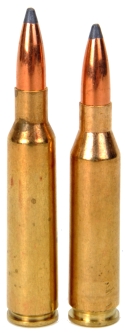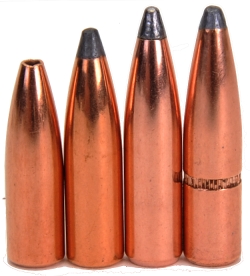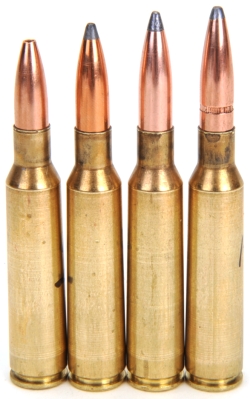 Based on performance, it may very well be impossible to have a permanent favorite firearm. No one knows what the future holds and no one knows what firearm will be encountered that hadn’t been seen before. If it were 1873, a state of the art breech loading Trapdoor Springfield would be looking pretty… sassy. However, if it were 1898 in the Philippines, that same rifle would seem a bit long in the tooth and down on performance. Fortunately, firearms are almost never purchased based on quantifiable performance, even though many claim they are, which explains why I have two mid level performance 6.5mm rifles… Sort of.
Based on performance, it may very well be impossible to have a permanent favorite firearm. No one knows what the future holds and no one knows what firearm will be encountered that hadn’t been seen before. If it were 1873, a state of the art breech loading Trapdoor Springfield would be looking pretty… sassy. However, if it were 1898 in the Philippines, that same rifle would seem a bit long in the tooth and down on performance. Fortunately, firearms are almost never purchased based on quantifiable performance, even though many claim they are, which explains why I have two mid level performance 6.5mm rifles… Sort of.
I purchased the CZ 550 Full Stock in 6.5×55 Swedish because it was and remains a beautiful rifle. Fortunately, it is also a proverbial tack driving, fast handling and compact. It’s big draw back is that it is a beautiful rifle so it is not going to get dragged through brush. Subsequently, a rifle with greater utility and similar ballistic performance was required. To that end a Remington Model Seven, chambered for the 260 Remington, was purchased. The box score comparison of the rifles looks a bit like this:
| Model | Ceska zbrojovka 550 Full Stock |
Remington Model Seven |
| Chamber | 6.5x55mm Swedish | 260 Remington |
| Magazine Capacity | 5+1Rounds | 4+1 |
| Barrel Length | 20.5″ | 20″ |
| Twist Rate | 1:9″ | 1:9″ |
| Hardware | Blued Steel | Blued Steel |
| Stock | Walnut | Walnut |
| Safety | 3 Position | 2 Position |
| Trigger | Single Set Adjustable | Adjustable |
| Trigger Pull | 2< lbs / 5 lbs | 2.5 – 4 lbs |
| Metallic Sights | 13″ radius | None |
| Scope Mounting | 0.80″ dovetail | D&T |
| Overall Length | 41 1/4″ | 39 1/4″ |
| Length of Pull | 14 1/4″ | 13 1/2″ |
| Weight (Actual) | 7 lbs 13 oz | 6 lbs 3 oz |
| MSRP | $864.00 | $1029.00 |
The tough, durable Remington could be used for… clearing underbrush and chopping firewood with comfort in the knowledge it would still shoot straight and hose off at the end of the day. The CZ full stock could then be pressed into service when hunting under ideal conditions when there was less chance of a tree branch scratch or close encounters with blood splatter.
Unfortunately, while shooting both rifles at the range, I was accosted by cheerleaders from each cartridge camp, each demanding to know why I had any association with the other. I escaped being blah, blahed to death by committing to conduct tests that would conclusively prove why the rifle they appreciated so much out performed the other. So here I am…
What’s rounder, an orange?

| Cartridge | Case Diameter “ |
Case Length “ |
Overall Length “ |
Grains Capacity “ |
| 6.5x55mm | 0.480 | 2.165 | 3.150 | 57.0 |
| 260 Remington | 0.471 | 2.035 | 2.800 | 53.5 |
| Nominal Dimensions and capacities | ||||
 The difference between the 6.5x55mm and the 260 Remington is a bit more extensive than this data suggests. While the 260 Remington is right at home in a short action rifle, the 6.5×55 Swedish is not. Subsequently, the 6.5x55mm is often found associated with a 30-06 Springfield length action.
The difference between the 6.5x55mm and the 260 Remington is a bit more extensive than this data suggests. While the 260 Remington is right at home in a short action rifle, the 6.5×55 Swedish is not. Subsequently, the 6.5x55mm is often found associated with a 30-06 Springfield length action.
There is a payoff for a couple of extra ounces of steel and 5 milliseconds longer bolt throw. The long action allows heavy weight and high ballistic coefficient bullets to be seated out further from the case mouth than would be possible with a short action 260 Remington. The result is greater preservation of case capacity when it is most needed. Of course, as is the case with most stated cartridge benefits, that is only meaningful if long heavy bullets are part of the game plan.

| Brand | Mfg # | Type | Grains | Construction | Length “ | B.C. |
| Sierra | 1710 | HP | 100 | Lead Core | 0.934 | 0.259 |
| Sierra | 1720 | Spitzer SP | 120 | Lead Core | 1.082 | 0.356 |
| Nosler | 16320 | Partition SP | 125 | Lead Core | 1.175 | 0.449 |
| Hornady | 2620 | Interlock SP | 129 | Lead Core | 1.175 | 0.445 |
Above are the four bullets I personally use the most, L-R: 100 grain Sierra Varminter, 120 grain Sierra Pro-Hunter, 125 grain Nosler Partition, and the 129 grain Hornady Interlock. Folks who like to do their shooting 1,000 yards away from a target tend to like, not pictured, 139 to 144 grain match bullets from Berger, Hornady, Lapua, Norma, Nosler, and Sierra. As an example, the Lapua 144 grain match bullet has an G1 BC of 0.636. They launch at a moderate velocity, but they are so slick, that they remain well above supersonic at 1,000 yards. They are just not the right design for deer hunting.
Static handload data is an ox-less moron…
 Many people think that term is “oxymoron”, but it is actually an expression borrowed from the ancient Latin dictum, “E pluribus stegosaurus platypus oxus moronus Unum”, which loosely translated as “He who leads his ox off a cliff is a bit of a moron”. Ergo, the guy who does not test his handload data periodically to validate components and firearm performance is probably on his way to becoming an ox-less moron. Below is a reshoot of data I’d posted earlier, reflecting new lots of powder, bullets and primers. The listed 6.5x55mm Swedish loads peak at approximately 60,000 PSI, well above the 55,000 PSI SAAMI standard and anything I would want to put through a military Mauser or a sporter made from a military Mauser. In fact, I do not use these loads in anything buy my CZ 550.
Many people think that term is “oxymoron”, but it is actually an expression borrowed from the ancient Latin dictum, “E pluribus stegosaurus platypus oxus moronus Unum”, which loosely translated as “He who leads his ox off a cliff is a bit of a moron”. Ergo, the guy who does not test his handload data periodically to validate components and firearm performance is probably on his way to becoming an ox-less moron. Below is a reshoot of data I’d posted earlier, reflecting new lots of powder, bullets and primers. The listed 6.5x55mm Swedish loads peak at approximately 60,000 PSI, well above the 55,000 PSI SAAMI standard and anything I would want to put through a military Mauser or a sporter made from a military Mauser. In fact, I do not use these loads in anything buy my CZ 550.
At the far right is evidence of what can be done with a moderate length cartridge in a long action rifle. I chose to skip the cannelure with the 6.5x55mm and Hornady bullet to regain some case capacity that ultimately pushed the 129 grain bullet over 3,000 fps… which caused me to want to try some 130 and 140 grain Berger VLD hunting bullets as a top load. With a BC of 0.612 for the 140, seems as though there is more to gain for both the 6.5x55mm Swedish and the 260 Remington.
Appearing on the table below in the order pictured above… really
|
||||||||||||||||||||||||||||||||||||||||||||||||||||||||||||||||||||||||||||||||||||||||||||||||||||||||||||||||||||||||||||||||||||||||||||||||||||||||||||||||||||||


Email Notification